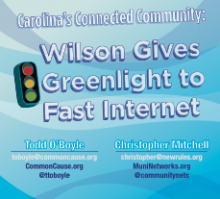
Fast, affordable Internet access for all.

Even as the Internet is changing every aspect of our lives and communities, most Americans are intimidated by confusing jargon and misconceptions about Internet policy. We are developing a series of fact sheets that make these issues understandable to everyone.
We presently have fact sheets from the Institute for Local Self-Reliance and other organizations that cover broadband, financing networks, wireless Internet, economic development benefits from community owned networks, and the public savings from community owned networks.
Stay up to date with these fact sheets and other developments in community owned networks, subscribe to our one-email-per-week list. Once a week, we send out an update with new stories and resources.
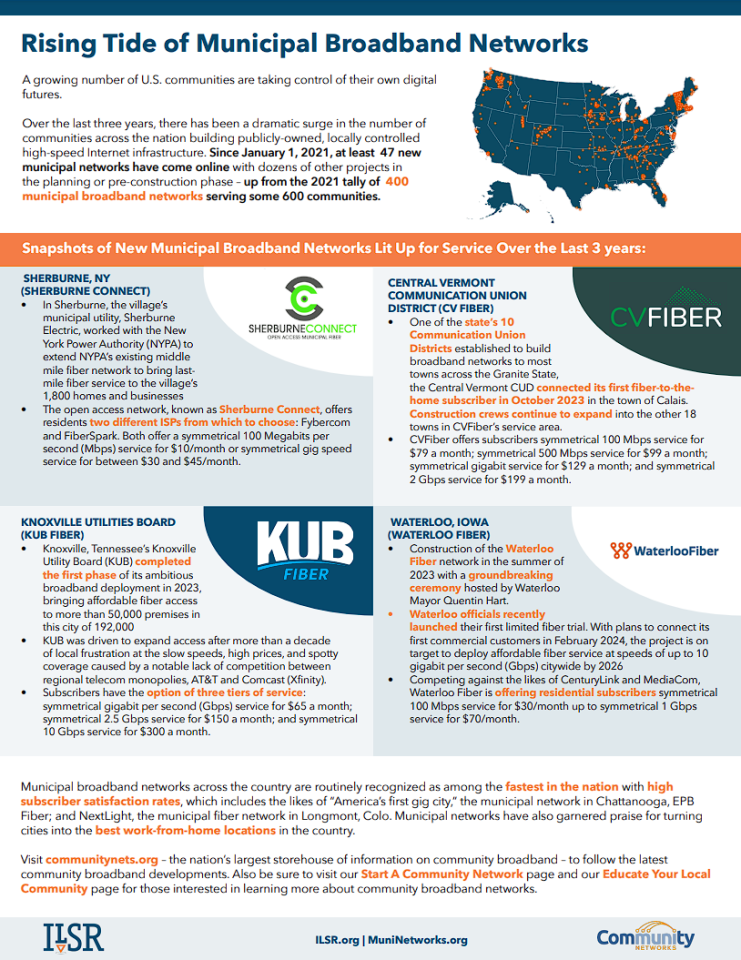
The municipal broadband movement continues to gain momentum. Since January 1, 2021, at least 47 new municipal networks have come online with dozens of other projects still in the planning or pre-construction phase, which includes the possibility of building 40 new municipal networks in California alone. To help encapsulate this dramatic surge in the number of communities building publicly-owned, locally controlled high-speed Internet infrastructure, we created this fact sheet to provide pertinent numbers and highlight four recently launched networks now providing service to communities hungry for high-quality Internet connectivity, choice, competition.
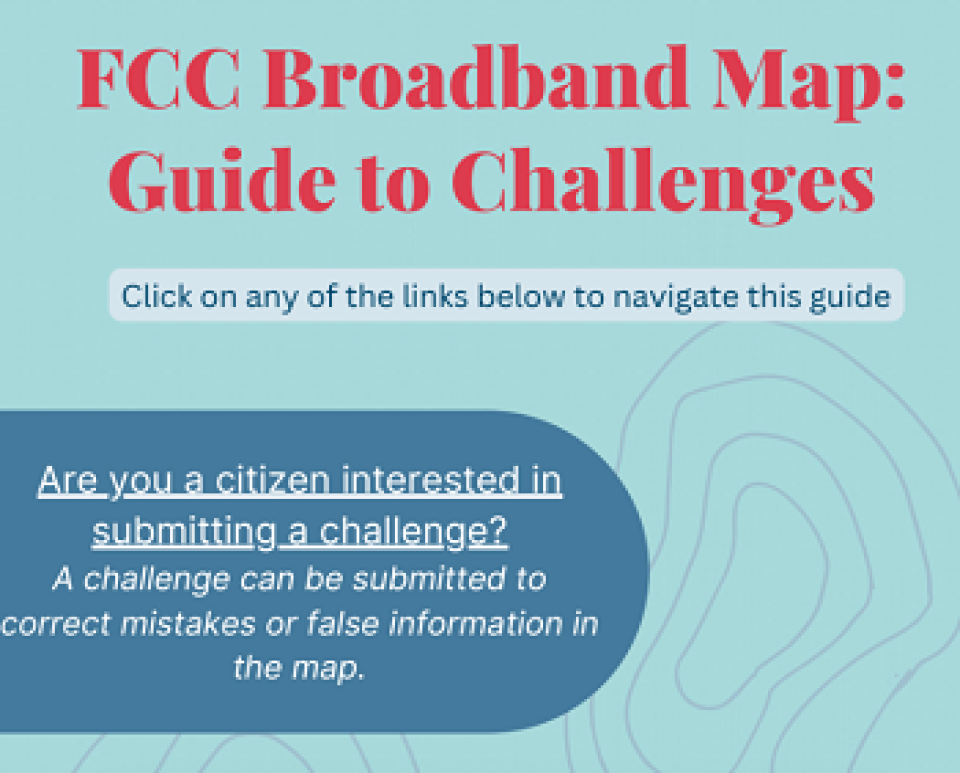
With good reason, many are confused about the information shown in the FCC's new Broadband Availability map, the challenge process, and why we should care about helping the FCC make corrections. We believe it is important to contribute to improving this map to enable an equitable allocation of Broadband Equity, Access, and Deployment (BEAD) Program funds to states next year. In an effort to provide a better understanding of the map itself and the challenge process we created a short series of instructional videos and a click-through guide. FCC Broadband Map Challenge Guide [pdf]
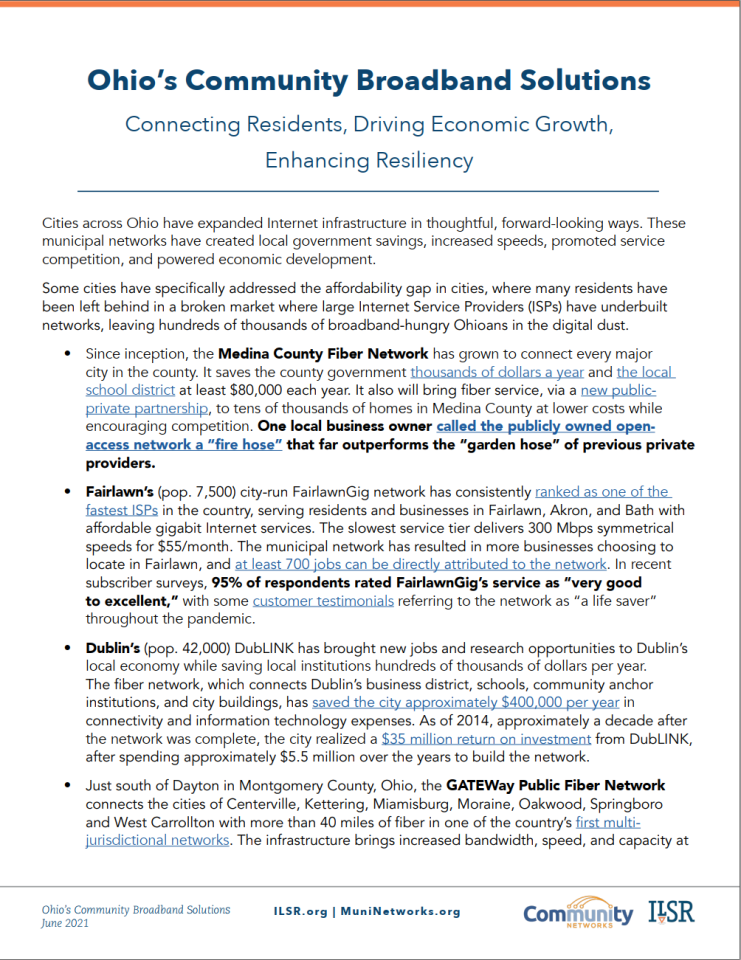
Cities across Ohio have expanded Internet infrastructure in thoughtful, forward-looking ways. These municipal networks have created local government savings, increased speeds, promoted service competition, and powered economic development. Some cities have specifically addressed the affordability gap in cities, where many residents have been left behind in a broken market where large Internet Service Providers (ISPs) have underbuilt networks, leaving hundreds of thousands of broadband-hungry Ohioans in the digital dust. This fact sheet outlines the many long-term benefits that municipal broadband projects have brought to the state.
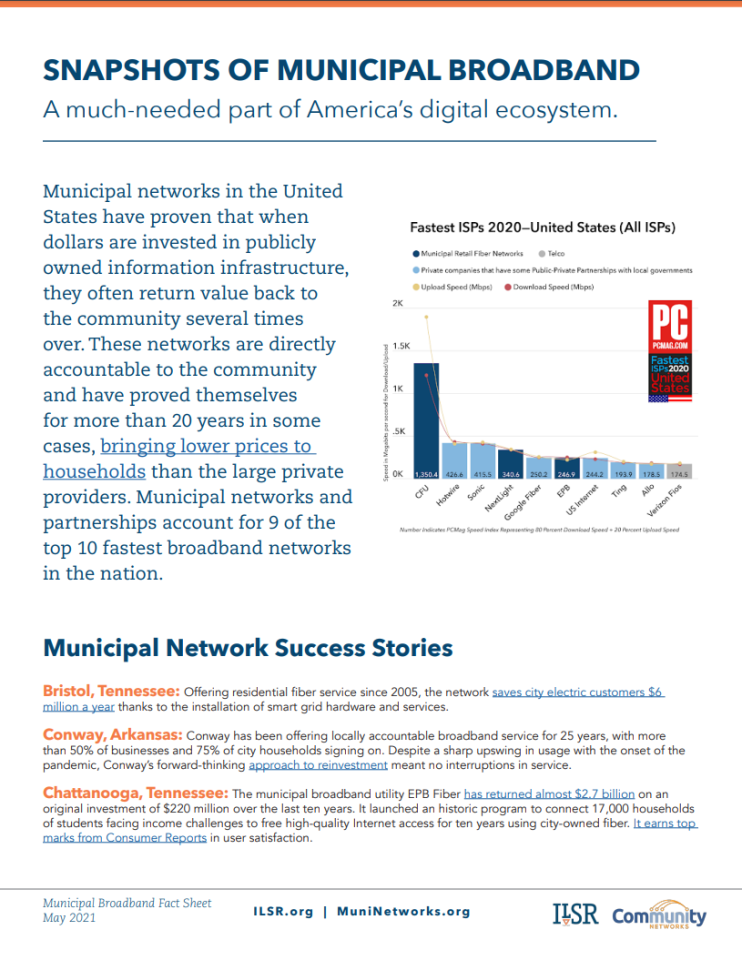
Municipal networks in the United States have proven that when dollars are invested in publicly owned information infrastructure, they often return value back to the community several times over. These networks are directly accountable to the community and have proved themselves for more than 20 years in some cases, bringing lower prices to households than the large private providers. Municipal networks and partnerships account for 9 of the top 10 fastest broadband networks in the nation. This new fact sheet highlights municipal broadband success stories from across the country and some of the many benefits the networks have brought to the communities they serve.
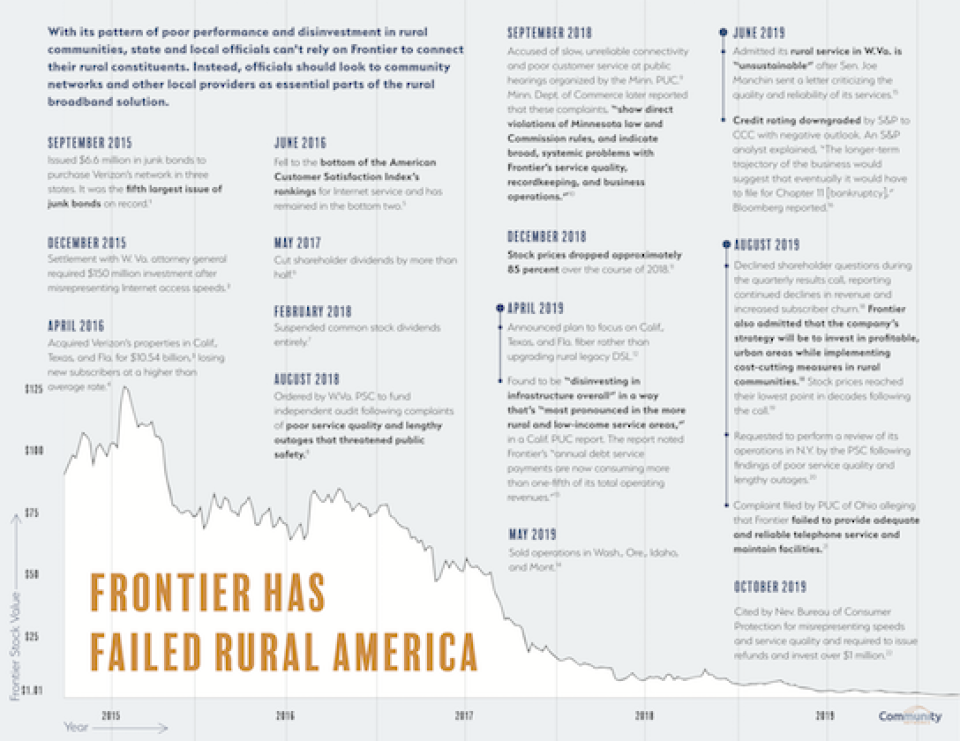
Despite raking in hundreds of millions in government broadband subsidies, Frontier Communications has failed time and time again to bring reliable, high-speed connectivity to the rural communities it serves. Instead of investing in network upgrades, Frontier has neglected its rural infrastructure to the detriment of its subscribers and the company’s own financials, with its worsening service quality paralleling its plummeting stock value. This fact sheet presents evidence of Frontier’s negligence and suggests that rather than continuing to trust Frontier, government officials should look to publicly owned and community-minded providers to connect rural residents, businesses, and institutions.
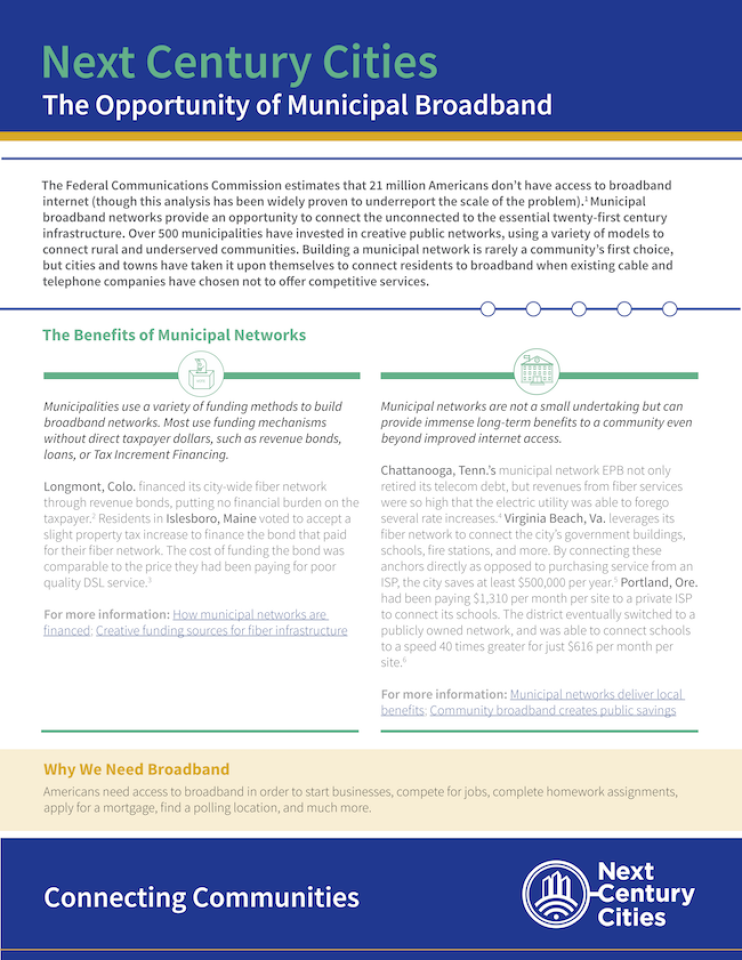
Next Century Cities (NCC) helps communities across the U.S. connect to each other, find resources, and discover ways to improve local Internet access options. NCC’s fact sheet uses examples from municipal network history. Communities have invested in publicly owned fiber optic infrastructure to obtain better connectivity and to reduce telecommunications costs for municipal facilities. In more than a few places, those investments became the foundation for what later became networks to serve local businesses and residences. The fact sheet also delves into other benefits, such as economic development, improved efficiency of other utilities, and accountability.
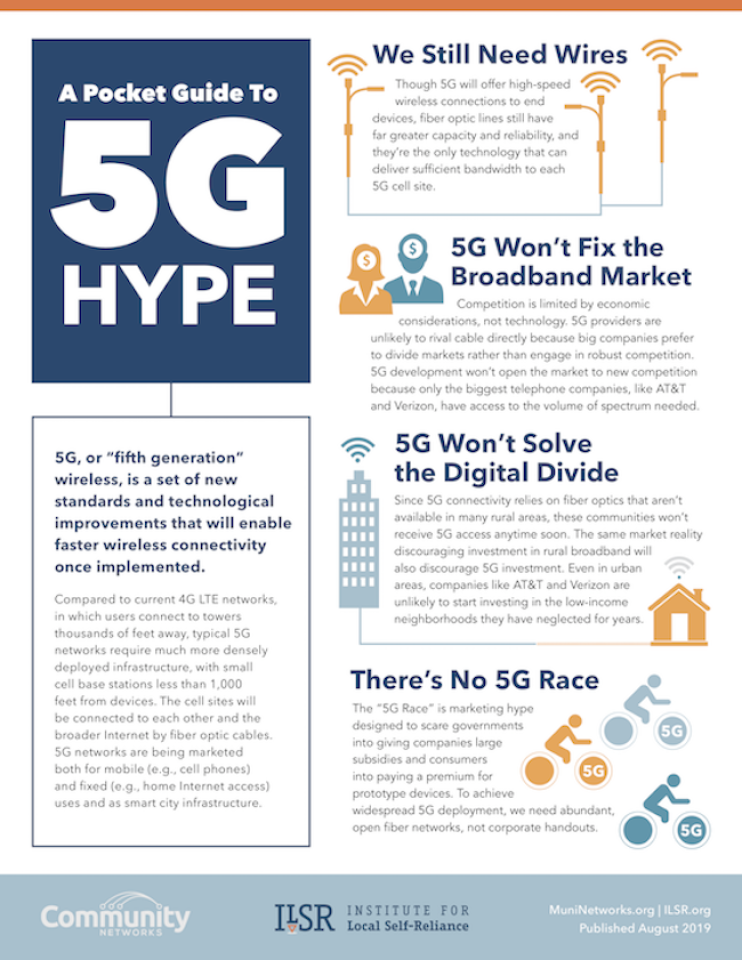
It’s difficult to separate 5G fantasy from reality as reported in traditional news sources. Misunderstandings surrounding the demands and capabilities of 5G has snowballed, creating an incorrect assumption that the technology will solve America’s many connectivity problems. It’s true that 5G is an improvement, but it has limitations. This fact sheet addresses the most repeated errors surrounding 5G and explains why the technology should be considered another tool, not an exclusive remedy.
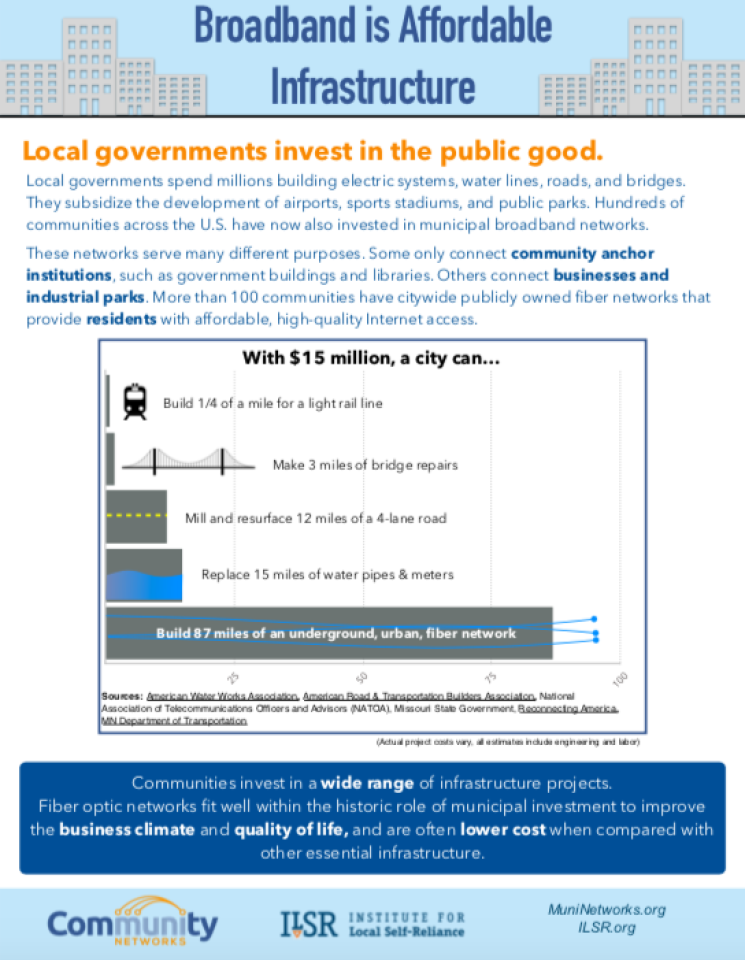
Local governments spend billions on all sorts of infrastructure every year to advance the public good for their communities. Roads and bridges keep day-to-day activity moving. Investments such as water and sewer infrastructure keep cities clean and livable. Fiber infrastructure is used for a wide range of purposes, including economic development, education, and to keep a city’s administration connected. To get a look at how fiber network infrastructure compares to other public investments, we've developed the Broadband is Affordable Infrastructure fact sheet.
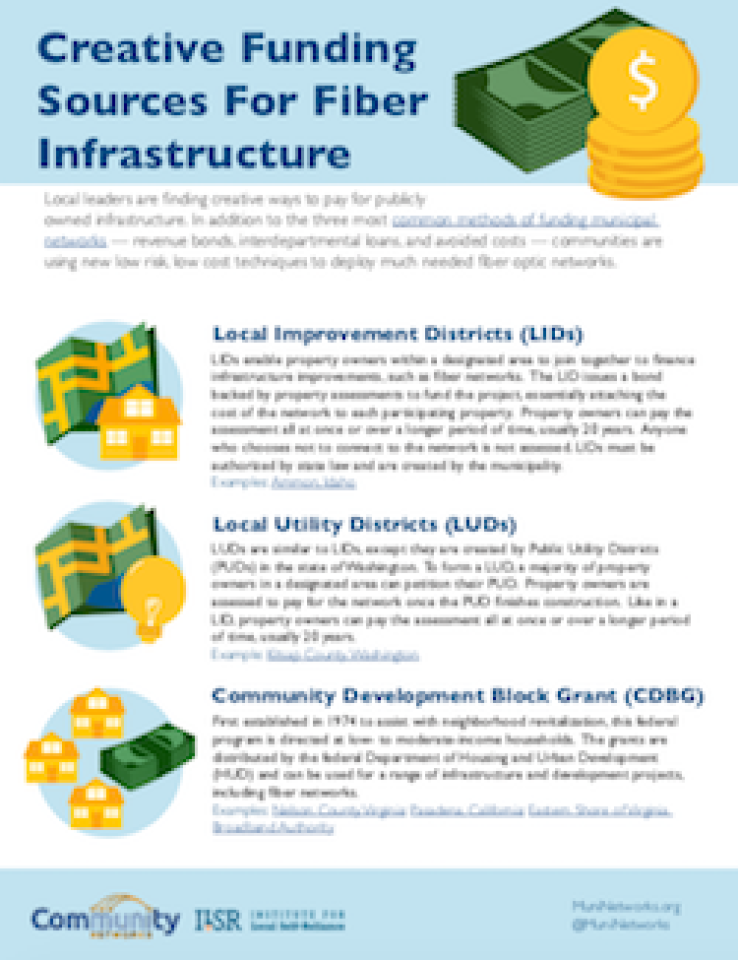
As interest in publicly owned broadband network infrastructure increases, local communities seek new ways to fund municipal networks. Revenue bonds, interdepartmental loans, and avoided costs have been the three most common methods for funding Internet network infrastructure, but local leaders are finding creative approaches to get the job done. In this fact sheet we analyze some new approaches to funding fiber optic infrastructure, pros and cons, and offer some examples.
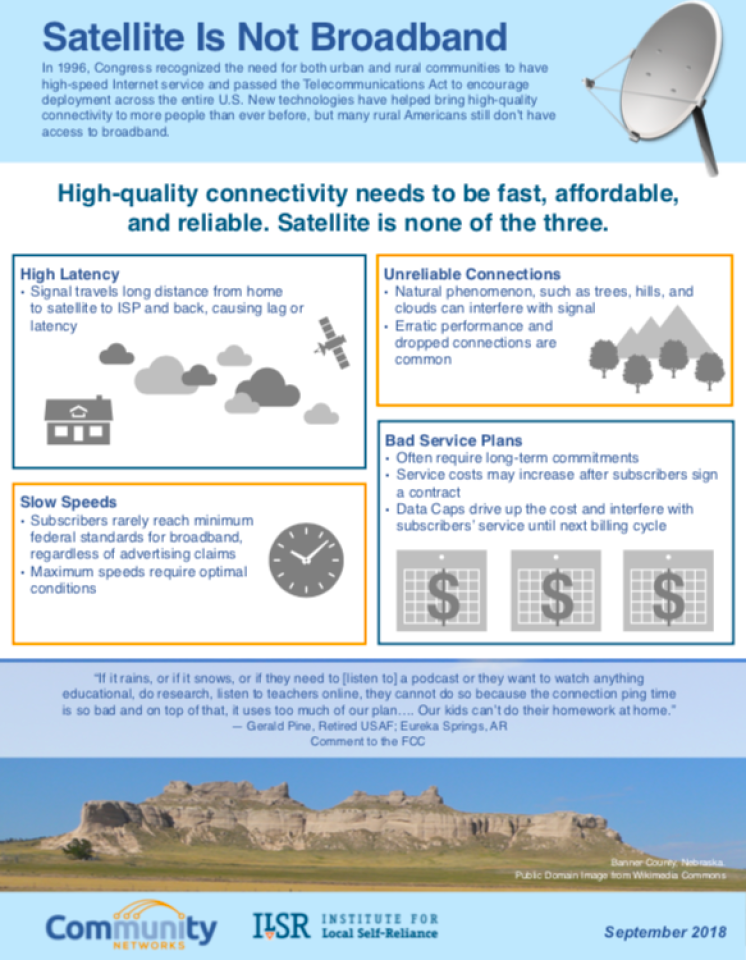
As a nation our goal is ubiquitous broadband coverage so every person, regardless of where they live, can obtain the fast, affordable, reliable Internet access necessary for modern times. For people in rural areas, where large national wireline providers don’t typically invest in the infrastructure for high-quality connectivity, satellite Internet access is often their only choice. In this fact sheet we address some of the reasons why depending on satellite Internet access to serve rural America is a mistake.
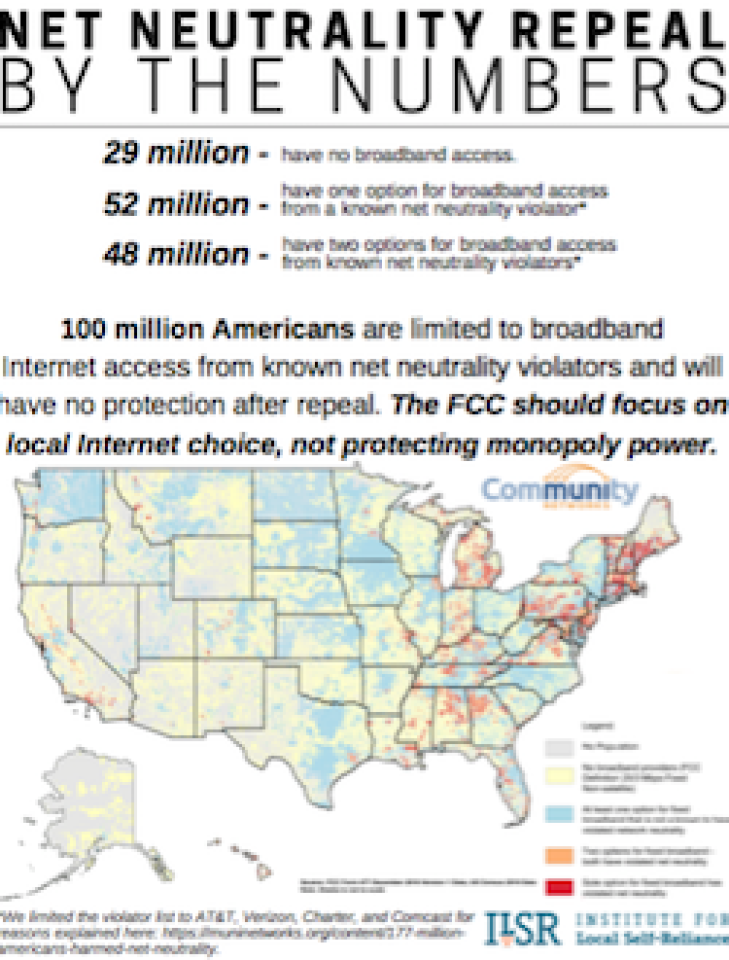
As the vote to repeal network neutrality protections approached in 2017, we started digging into the FCC’s data to determine how eliminating the policy would affect subscribers whose ISPs might take advantage of future changes. We learned that, due to existing monopoly and duopoly conditions, many millions of people would have no recourse but to pay known network neutrality violators for Internet access. We developed visuals and facts sheets with frank data that describes the problem in the U.S., California specifically, and on the East Coast from Maine to Virginia.
Net Neutrality Repeal By The Numbers, U.S.A. Edition fact sheet [pdf].
Net Neutrality Repeal By The Numbers, California Edition fact sheet [pdf].
Net Neutrality Repeal By The Numbers, East Coast Edition fact sheet [pdf].
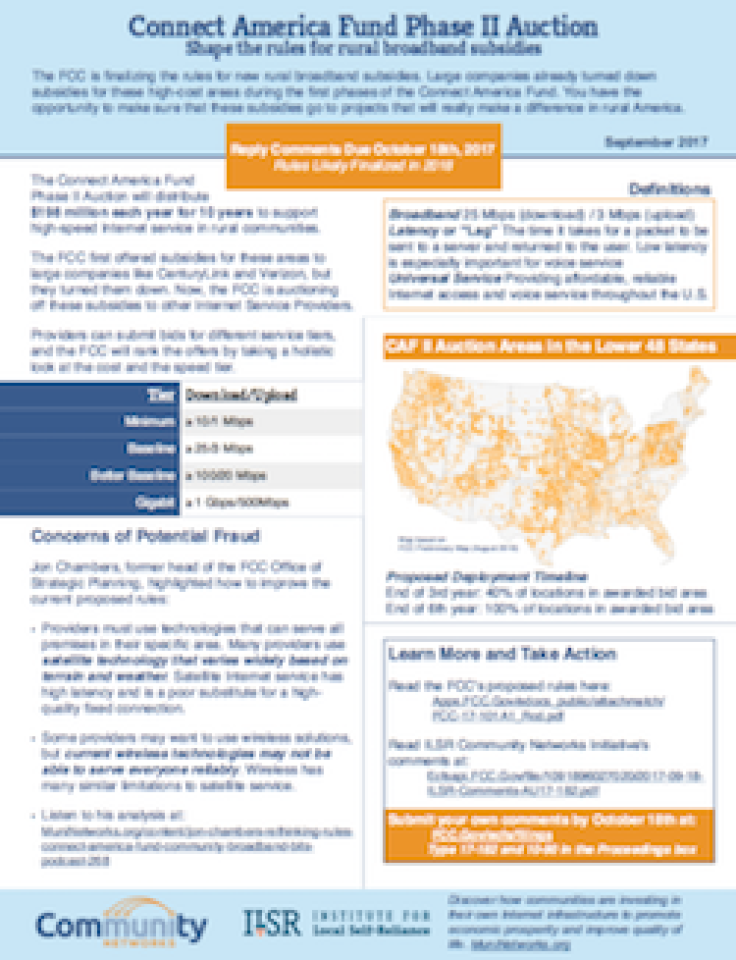
The Federal Communications Commission (FCC) manages the CAF program, which provides billions of dollars in subsidies to Internet service providers for areas where the cost of building networks is prohibitive. Some large providers decided not to accept some of the subsidies during Phase I - about $198 million annually for 10 years. This fact sheet details the most important aspects of the Connect America Fund (CAF) Auction. What is it? What should it do? Who does it affect?
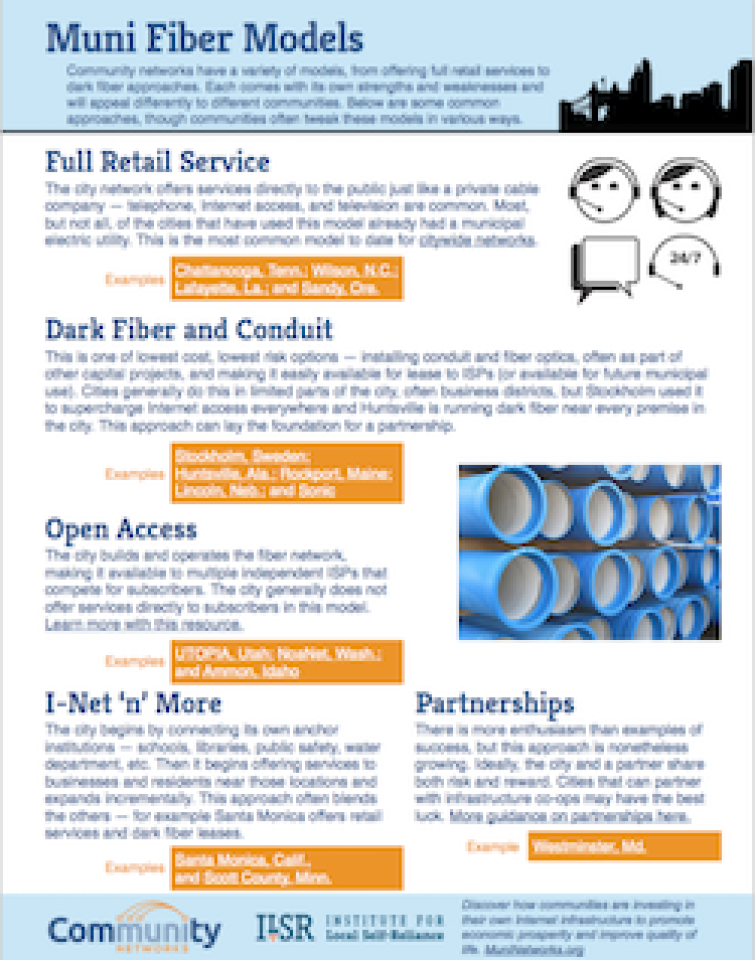
When you think “municipal fiber network,” you may think Chattanooga or Wilson, North Carolina - places where the city utility offers retail services directly to subscribers. That’s only one of several possible models that are emerging as an increasing number of communities use publicly owned assets to improve local connectivity. This fact sheet offers five of the most well known models that local governments are investigating and implementing as they become more self-reliant. Examples and characteristics of each model help illustrate.
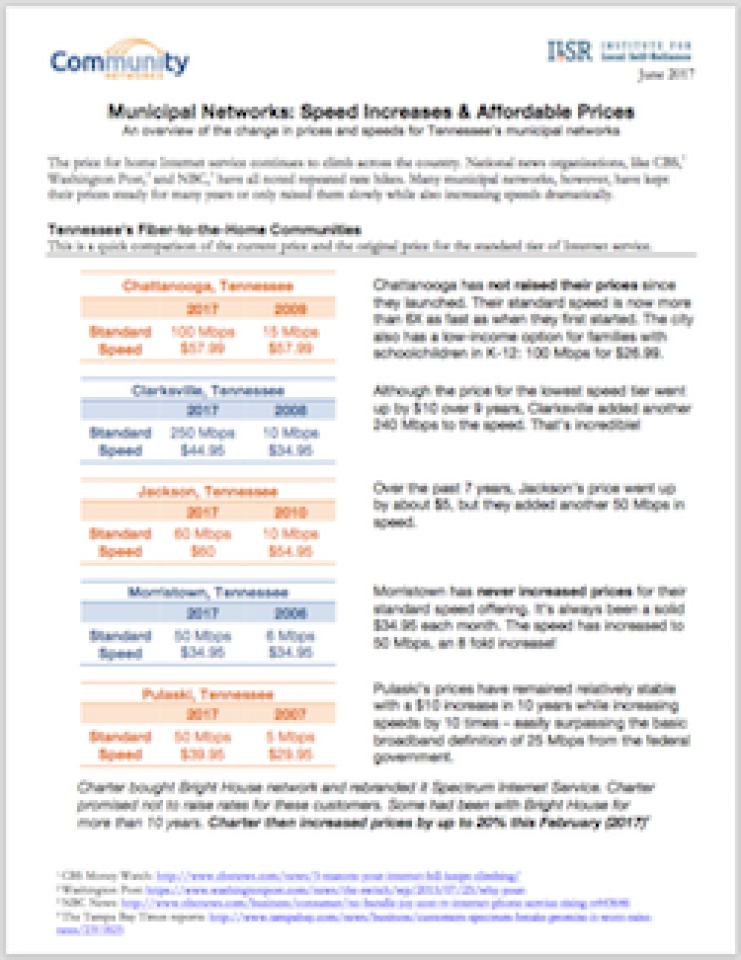
The large corporate national Internet Service Providers seem to raise their monthly rates every year but don’t give subscribers anything more for their money. On the flip side, we noticed that municipal networks tend to increase speeds for subscribers with very modest or no price increases over long periods of time. In order to illustrate this phenomenon, we looked back in time at rates and speeds in eight Tennessee communities that have invested in publicly owned Internet network infrastructure. You will see how speeds have increased significantly, but rates have only inched up.
Municipal Networks: Speed Increases & Affordable Prices [pdf]
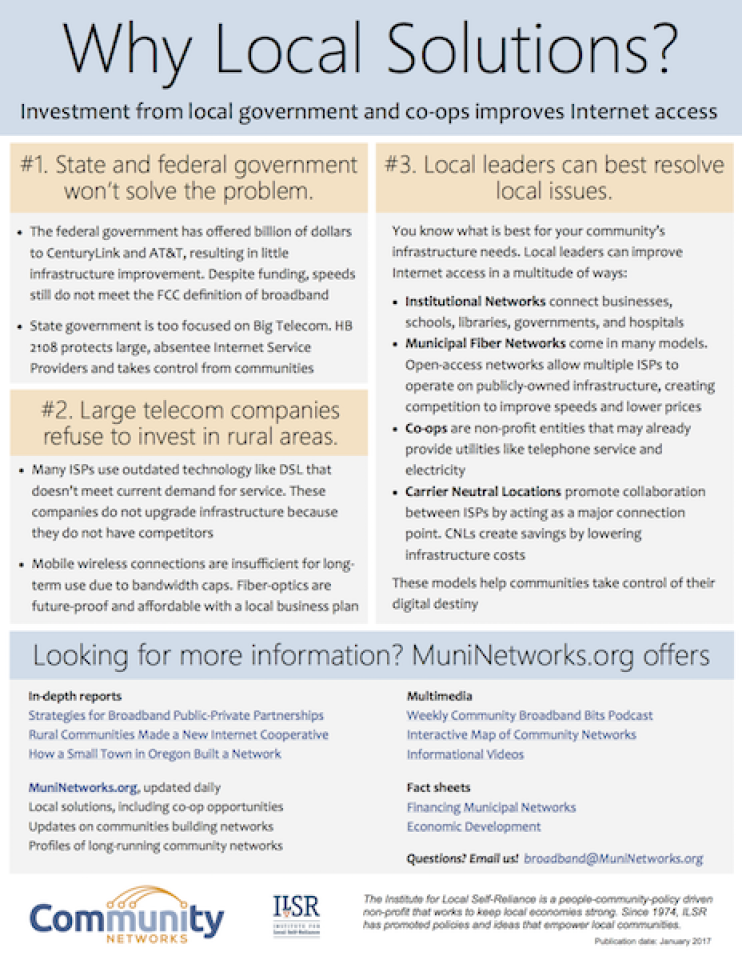
The next time you’re attending a city council meeting, a local broadband initiative, or just chatting with neighbors about better local connectivity, take a few copies of our fact sheet. In addition to providing some basic talking points to get the conversation moving, the fact sheet offers resources to guide you to more detailed information on publicly owned Internet networks. You've already started to get people interested in all the advantages of high-quality connectivity, now show them how local self-reliance it the most direct route to better access.
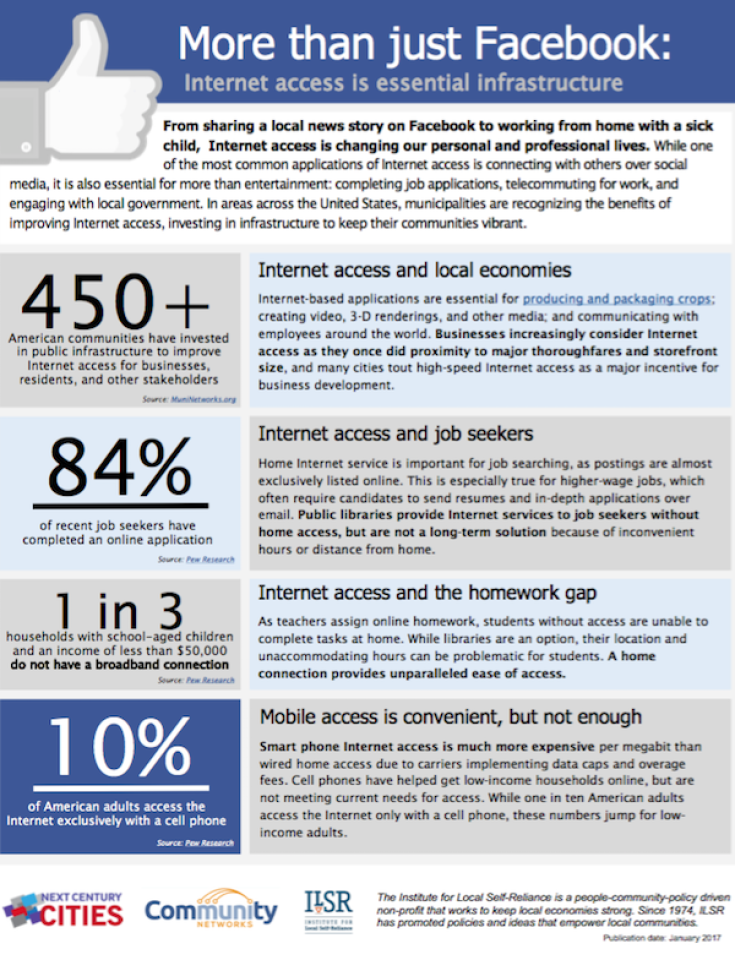
This fact sheet provides an overview on how Internet access and fast, affordable, reliable connectivity reaches most aspects of our lives. It provides statistics on economic development, education, and methods of delivering Internet access and is a good introductory tool that points out how Internet access is much more than just social media.
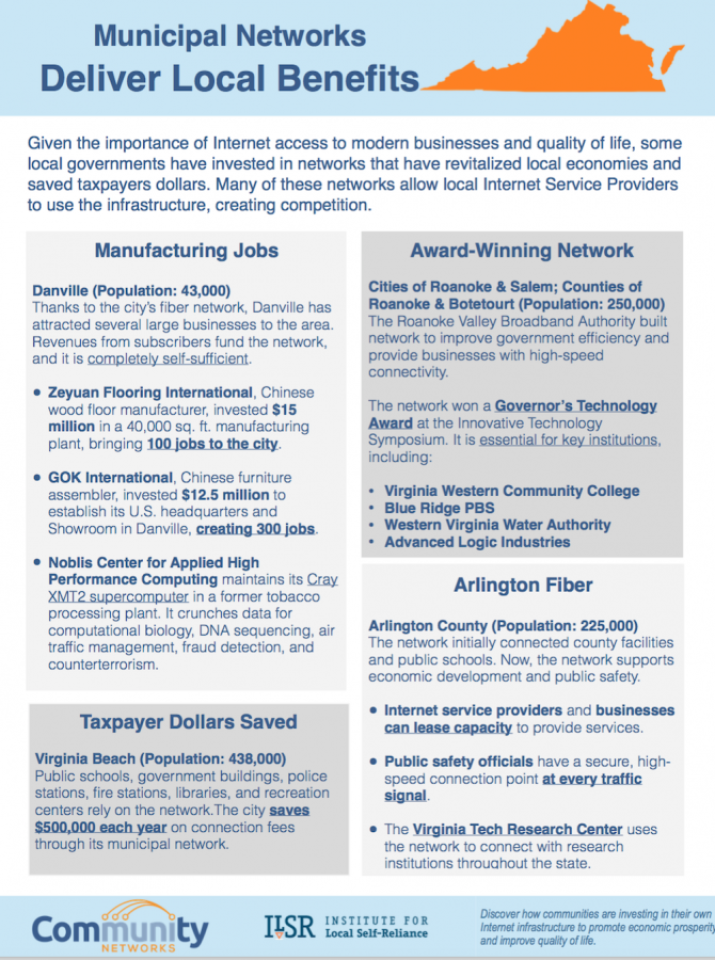
This fact sheet on municipal networks in Virginia describes how economic development, public savings, and better connectivity have contributed to the health of local communities with publicly owned networks. Virginia local governments have improved public safety, healthcare, and connectivity in local schools. Rural areas are better able to compete for high-tech and manufacturing jobs because high-speed connectivity is now an essential service for day-to-day business.
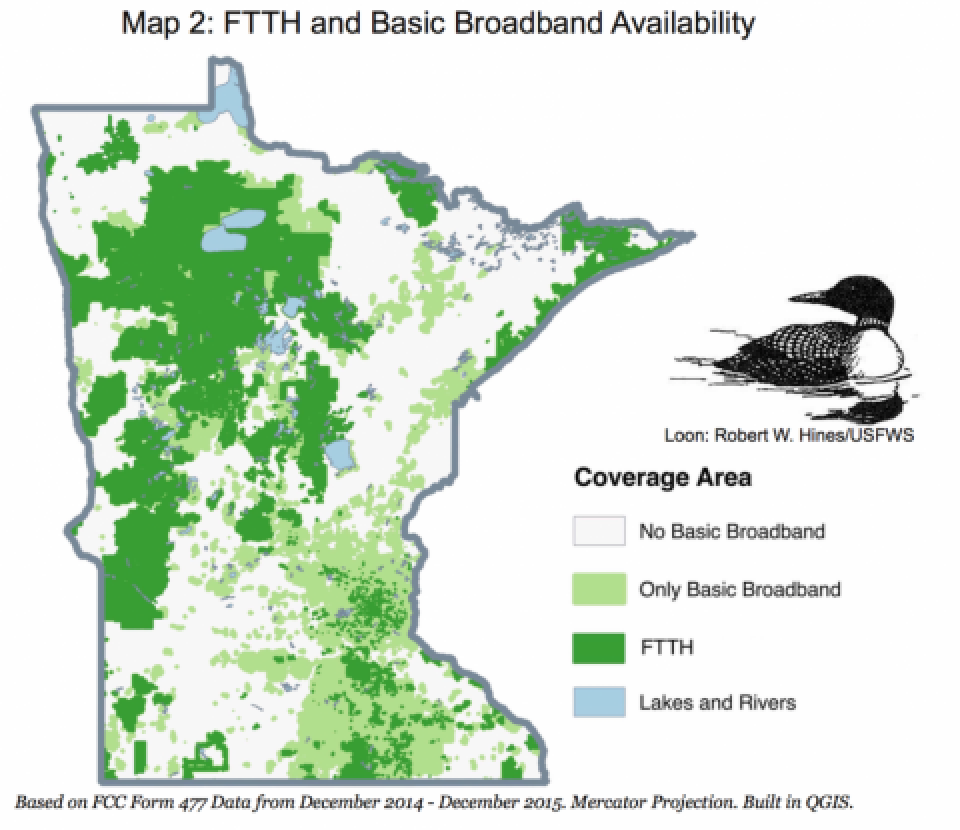
This fact sheet highlights the great work that Minnesota cooperatives and municipalities have done to bring fast, affordable, reliable Internet service to rural areas throughout the state. They've built many Fiber-to-the-Home (FTTH) networks, but there is still much work left to do. One in 4 Minnesotans lives in a rural area, and of those rural households, 43 percent lack access to broadband, defined by the FCC as 25 Megabits per second (Mbps) download and 3 Mbps upload. Resilient, robust, fiber is the long-term goal, but fixed wireless can help extend coverage in hard-to-reach rural areas.
Minnesota Cooperatives and Local Governments Can Solve Rural Digital Divide[pdf]
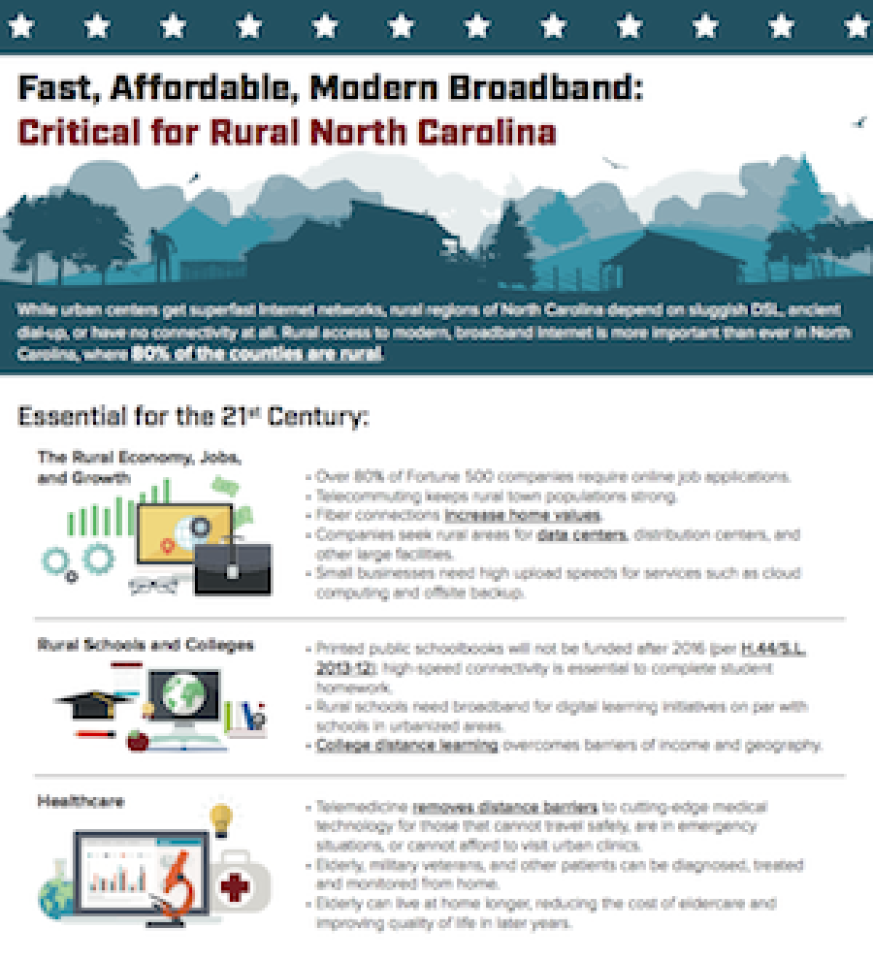
This fact sheet emphasizes the deepening divide between urban and rural connectivity. The fact sheet can help describe why people who live in the country need services better than DSL or dial-up. This tool helps to visualize the bleak situation in rural North Carolina, how it can be improved, and offers links to resources.
Fast, Affordable, Modern Broadband: Critical for Rural North Carolina [pdf]
Communities across the nation have invested in publicly owned cable and fiber infrastructure. ILSR's Community Networks Map documents over 500 communities where municipal networks serve residents and businesses. This fact sheet provides a quick introduction to the interactive online map.
When a community decides it needs to establish its own publicly owned network infrastructure, one of the biggest challenges is financing the investment. Each community is unique but three main methods of financing are most popular. This fact sheet offers a quick look at these common approaches and provides real-world examples.
This is a handy resource for elected officials and activists that are confused by some of the jargon or just want to make sure they understand some key ideas around broadband and telecommunications.
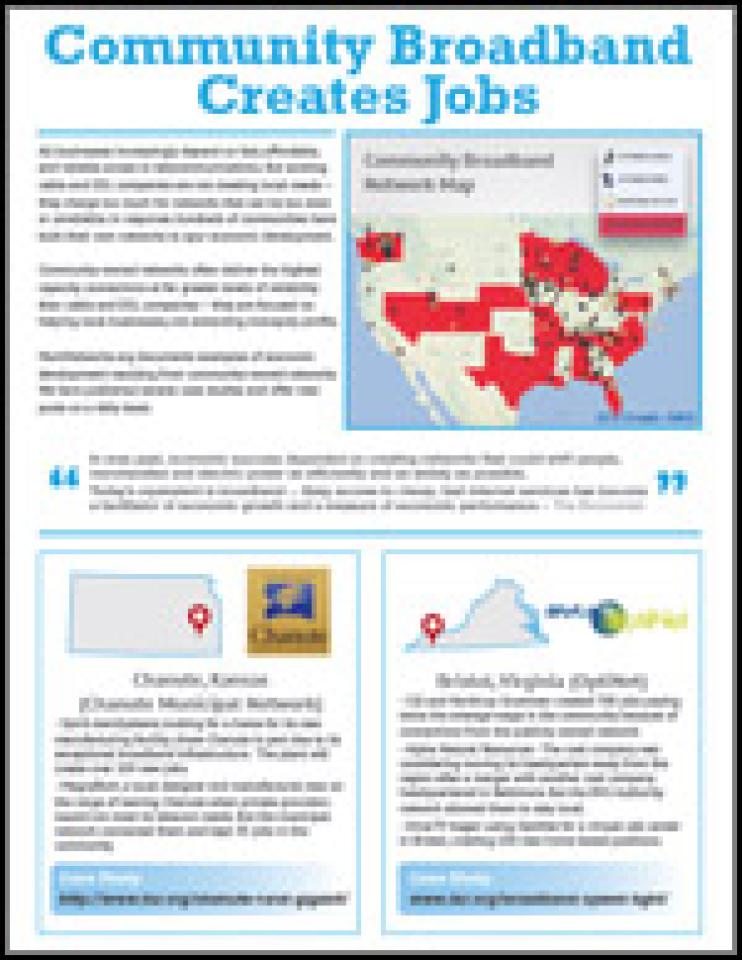
Community Broadband Networks have a very good track record in creating jobs. This fact sheet details where publicly owned network attracted new businesses or helped existing businesses to thrive.
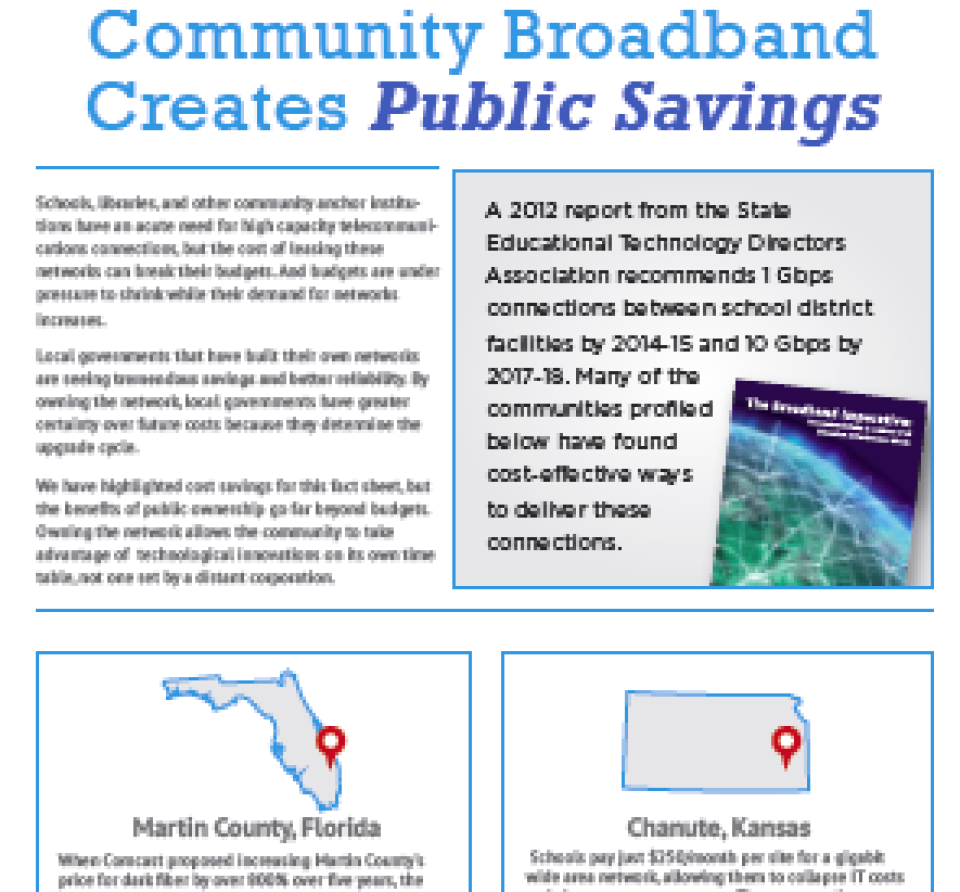
Though schools, libraries, and other community anchors need access to faster, more reliable networks, the big cable and telephone companies have priced those services so high that they are breaking the budget. But when communities create their own connections, affordable high capacity connections aren't the only benefits.
Wireless networks may appear to be magical, but are actually driving investment in fiber optic wires. This resource defines many terms, key points, common speeds, and offers insight into wireless technology and policy.
This 2 page fact sheet explores the issue of preemption - how at least 19 states have made it impossible or more difficult for communities to build their own networks. It includes some history, legal issues, and quotes from FCC Commissioners.
If you are a 21st century crafter, you are probably prolific at finding inspiration online. You may be familiar with American Crafts of Orem for ideas or products. The company, founded in 1994, is now a customer of UTOPIA and reports significant bandwidth improvement after the switch from old T-1 connections. From the UTPOIA blog:
With a robust e-commerce presence, American Crafts has to rely on its network. According to Kris Barlow, IT Manager, before switching to UTOPIA, the firm used a single T-1 connection, along with two additional T-1 connections to connect a remote warehouse in Provo. “Our Provo location was using an iProvo connection at the time. By switching to UTOPIA, we could use a single fiber connection to our headquarters building which provided much faster Internet speeds—up to 10 Mbps on our service plan, as compared with traditional T-1 speeds.”
Barlow also notes how the switch has allowed the company to consolidate headquarters and warehouse locations. Reliablity has also been a key improvement:
“In the three years that we've had UTOPIA service, I can remember only two or three service interruptions, all of which were resolved within the same day and were not related specifically to our connection,” he says. “Using the UTOPIA network has allowed us to drastically reduce the fee that we pay for Internet service when compared to the T-1 connections we were previously using, all while also drastically increasing the bandwidth of the connection.”
Because UTOPIA is open access, the company could keep the same phone provider, as it is an ISP on the UTOPIA network. The switch was seamless:
“This allowed for us to simply add the UTOPIA service to our current provider’s bill and allowed us to avoid the hassle of establishing a new account with a new provider,” Barlow says.
We are pleased to announce that an excerpt of our report, Chanute's Gig: One Rural Kansas Community's Tradition of Innovation Led to A Gigabit and Ubiquitous Wireless Coverage, is now highlighted in the newest Broadband Communities Magazine. The November/December 2012 issue focuses on economic development.
Editors chose our report because it shows how a community can successfully develop a network to address community needs. The result is greater economic development and a range of increased community benefits. In addition to our report, several other articles focus on economic development and come from authors such as Reed Hundt and Blair Levin, Doug Adams and Michael Curri, Ken Demlow, Craig Settles, and David Moore.
You can access the digital edition online and see the entire issue table of contents at Broadband Communities Magazine Online.
You can still download the full report from the ILSR website and check out some of our other resources including case studies, fact sheets, video and audio.
Cottage Grove, Oregon, is on the cusp of adding up to 250 new jobs with the aid of its fiber optic network. A recent Register-Guard.com article by Serena Markstrom details the potential project between the City and First Call Resolution. The company is interested in expanding to a Cottage Grove shopping strip. While the space is the right size and location, it does not have the needed telecommunications connections for a high-capacity call center.
The City is looking into expanding its fiber optic network to accommodate First Call. City leaders will seek a state economic development grant and recently approved funding for an engineer's construction plan to lay the cable to get an accurate cost estimate. Initial estimates are $450,000 for an entire underground installation. Council members have already suggested that the expansion makes sense, regardless of whether or not First Call becomes a tenant. The 7 miles of fiber are primarily located in the southern part of the city while the shopping strip is in the north.
The City Manager Richard Meyers hopes the added infrastructure will bring more than just First Call Resolution to the shopping strip. From the article:
The commercial strip being considered for the call center has much empty space. “The whole plaza needs help,” Meyers said. “We need to do something to see if we can get other things in there.”
If more businesses moved in and started leasing the cable, the city could collect money — just like any utility — from those who tapped into the network and use those funds to continue to expand fiber optic cable around town, Meyers said.
“With our fiber and what we’ve developed, we’re within 4,000 feet of connecting” to the Village Center, he said. “That’s how close we are,” he said. “It’s not a huge distance. We can do it. (It would be a) piece of cake to connect our system to his network and so all of [First Call Resolution's] call centers would be on the same network.”
The city network also offers a Wi-Fi network throughout 80% of the city. Rates vary, ranging from 10 free hours each month at 128 Kbps to 7 Mbps unlimited with tech support for $50 per month. According to the CGWiFi website:
Kudos to Richard Downey, Village Administrator for the Village of Kronenwetter in Wisconsin. Mr. Downey reminded us that we have yet to write about the fiber network in Princeton, Illinois. While we have noted Princeton in our list of economic development successes, we haven't delved into the network that serves the city, the schools, and the business community.
Princeton is home to about 7,500 people and is located in the north central region of the state in Bureau County. They have their own electric, water, and wastewater utilities and began offering broadband connectivity in late 2003. We spoke with Jason Bird, Superintendent of Princeton Electric Department, who shared the network's story with us.
In 2003, the city’s largest electric and water consumer was also the largest employer. At the time, incumbents served the community with T1 connections. The manufacturing company moved to Mexico, taking 450 jobs with it. The community was stunned.
Approximately 6 months later, Ingersoll Rand, the community's second largest employer with about 300 jobs, also considered moving away from Princeton. While lack of needed broadband was not the only reason, the Ingersoll Rand CEO let community leaders know that it was one of the influential factors. The company liked being in Princeton, and the city would have been on the top of the location list if not for the sad state of connectivity. At the time, the only commercial option was unreliable T1 connections for $1,500 - $2,000 per month. If Ingersoll Rand moved, the community would experience job losses equal to 10% of the population. Community leaders needed to act and do it quickly.
To retain Ingersoll Rand, the City Council decided unanimously to go into the telecommunications industry. They issued an RFP and encouraged incumbents AT&T and Comcast to bid; neither were interested. (Interestingly, once Princeton let it be known that they were going to build the network without them, there were some local upgrades from both companies.)
As I recently mentioned in my endorsement of Tubes by Andrew Blum, the book explains how a municipal fiber network helped to attract Google to town. Google sited its first "built-from-scratch data center" there, a $600 million investment according to Stephen Levy. According to Blum, it all started back in 2000 when the community got fed up with incumbent telephone company Sprint.
The Dalles was without high-speed access for businesses and homes, despite the big nationwide backbones that tore right through along the railroad tracks, and the BPA's big network. Worse, Sprint, the local carrier, said the city wouldn't get access for another five to ten years. "It was like being a town that sits next to the freeway but has no off-ramp," was how Nolan Young, the city manager, explained it to me in his worn office...
The Dalles was suffering economically due to its reliance on industrial jobs that were slowly disappearing.
